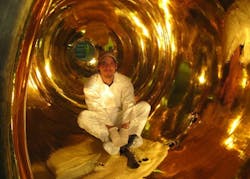NIST again selects Epner Laser Gold as its infrared reflectivity standard
The National Institute of Standards and Technology (NIST) has once again selected Laser Gold [trademark] as the new gold standard for infrared reflectivity. Laser Gold is a proprietary electroplated process developed by the hundred-year-old New York precious metals plating firm, Epner Technology (Brooklyn, NY). The process is unique in that it is both ultrapure (.9999), while also three times harder than any other 24 Kt. gold.
NIST calibrated some 20 copper mirror substrates that had been single-point diamond fly cut to a surface roughness of 50 Angstroms by the Kugler Group (Salem, Germany) and then plated, first with pure nickel followed by Laser Gold, each about a micron thick.
The Gaithersburg, MD laboratory in which the reflectance measurements are preformed is the "Fourier Transform Infrared Spectrophotometry (FTIS)" facility, which is described here. The specific instrument used to measure the standards is the "Infrared Reference Integrating Sphere (IRIS), which is described here. The result was an astounding 99% throughout the mid-infrared range of 2 to 14 microns. The new gold standard entered the NIST catalog of Standard Reference Material as SRM #1929.
"It all started with a chance meeting with a Xerox engineer at a 1972 trade show which took our 65-year-old company into the world of high technology electroplating for infrared reflectivity," said David Epner, president of Epner Technology. "Xerox needed a gold-plated aluminum reflector behind a quartz infrared lamp which generated the heat that fused the toner onto the paper. That's why Xerox copies come out of the machine warm.
Epner continued, "They were having difficulty finding a supplier whose plating could withstand the extreme heat of the lamp without blistering the plating off the aluminum while also meeting their reflective requirements. After a successful sample, Xerox tooled our company with a $60,000 infrared spectrophotometer which gave our engineers the 'eyes' to inspect the reflective performance of the gold plating and continuously tweak the process to achieve higher and higher reflectivity. That effort culminated in this NIST designation."
NASA is currently using Laser Gold because of its peerless heat reflecting properties and has specified this process for thermal control on countless spacecraft instruments beginning some 35 years ago to the early GOES weather satellites as well as the Hubble camera housing and more recently, on both the near- and mid-infrared cameras aboard the James Webb Space Telescope.
Laser Gold came to the attention of the Academy of Motion Picture Arts and Sciences, and this hard, pure, space-qualified gold plating has been "dressing" the Oscars for the last three award seasons.
SOURCE: Epner Technology via CISION PR Newswire; https://www.prnewswire.com/news-releases/epner-technology-produces-nist-new-gold-standard-300784725.html

Gail Overton | Senior Editor (2004-2020)
Gail has more than 30 years of engineering, marketing, product management, and editorial experience in the photonics and optical communications industry. Before joining the staff at Laser Focus World in 2004, she held many product management and product marketing roles in the fiber-optics industry, most notably at Hughes (El Segundo, CA), GTE Labs (Waltham, MA), Corning (Corning, NY), Photon Kinetics (Beaverton, OR), and Newport Corporation (Irvine, CA). During her marketing career, Gail published articles in WDM Solutions and Sensors magazine and traveled internationally to conduct product and sales training. Gail received her BS degree in physics, with an emphasis in optics, from San Diego State University in San Diego, CA in May 1986.
